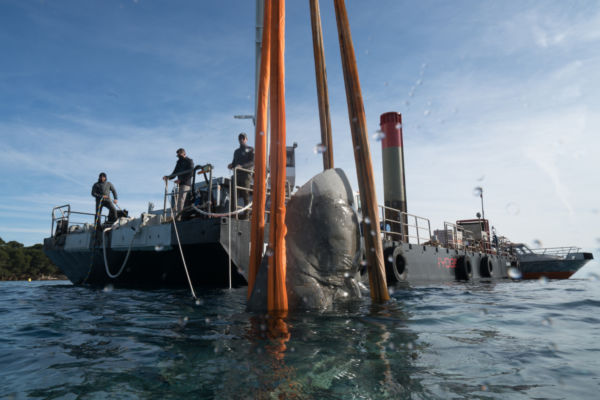A new underwater museum in Cannes, France, opened on February 1st, 2021. Funded by the Mairie de Cannes and commissioned by its mayor, David Lisnard, the project took over four years to develop.

The Museum is Jason de Caires Taylor’s first installation in the Mediterranean Sea. It features a series of six monumental three-dimensional portraits, each over 6.5 feet (2 m) in height and 10 tons in weight. They are sited near the island of Sainte-Marguerite, one of the Lérins Islands, just off the coast of Cannes, France. Placed at a depth of between 6.5 to 10 feet (2 to 3 m), these artworks rest on areas of white sand, in between oscillating Posidonia seagrass meadows in the protected southern part of the island. The shallow depth and close proximity to shore make the site easily accessible, and the crystal-clear waters provide ideal conditions for snorkeling. This is one museum you can access in a socially-distant way — wearing a scuba mask over your eyes rather than a mask over your mouth.
The six works are based on portraits of local community members, covering a range of ages and professions — for example, Maurice – an 80-year-old local fisherman, and Anouk, a 9- year-old elementary school pupil. Each face is significantly upscaled and sectioned into two parts, the outer part resembling a mask.
The split mask is a metaphor for the ocean. One side of the mask depicts strength and resilience, the other fragility and decay. From land, we see the surface, calm and serene, or powerful and majestic. This is the view of the mask of the sea. However below the surface is a fragile, finely-balanced ecosystem – one which has been continuously degraded and polluted over the years by human activity.
The theme of masks connects to the history of Île Sainte-Marguerite, well known as the location where the Man with the Iron Mask was imprisoned. Cannes, through its famous annual film festival, is well known for its relationship with the performing arts.
The location of the sculptures was previously an area of disused marine infrastructure. Part of the project was a significant clearing of the site, including removing marine debris such as old engines and pipelines to create a space for the installation of artworks. All pieces were specifically designed with Ph neutral materials to attract marine fauna and flora. The site has now been cordoned off from boats, making it safe for snorkelers and divers, and preventing damage by anchors to the seagrass meadows. Posidonia grass is a vital habitat area and is sometimes referred to as the lungs of the ocean for the vast amount of oxygen it creates. With all his projects, de Caires Taylor aims to draw attention to the sea as a fragile biosphere in urgent need of protection.






